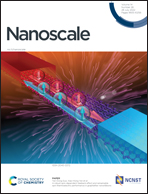Green chemistry and first-principles theory enhance catalysis: synthesis and 6-fold catalytic activity increase of sub-5 nm Pd and Pt@Pd nanocubes†
Abstract
Synthesizing metal nanoparticles with fine control of size, shape and surface properties is of high interest for applications such as catalysis, nanoplasmonics, and fuel cells. In this contribution, we demonstrate that the citrate-coated surfaces of palladium (Pd) and platinum (Pt)@Pd nanocubes with a lateral length <5 nm and low polydispersity in shape achieve superior catalytic properties. The synthesis achieves great control of the nanoparticle's physico-chemical properties by using only biogenic reagents and bromide ions in water while being fast, easy to perform and scalable. The role of the seed morphology is pivotal as Pt single crystal seeds are necessary to achieve low polydispersity in shape and prevent nanorods formation. In addition, electrochemical measurements demonstrate the abundancy of Pd{100} surface facets at a macroscopic level, in line with information inferred from TEM analysis. Quantum density functional theory calculations indicate that the kinetic origin of cubic Pd nanoshapes is facet-selective Pd reduction/deposition on Pd(111). Moreover, we underline both from an experimental and theoretical point of view that bromide alone does not induce nanocube formation without the synergy with formic acid. The superior performance of these highly controlled nanoparticles to perform the catalytic reduction of 4-nitrophenol was proved: polymer-free and surfactant-free Pd nanocubes outperform state-of-the-art materials by a factor >6 and a commercial Pd/C catalyst by more than one order of magnitude.

- This article is part of the themed collection: Celebrating International Women’s Day: Women in Nanoscience


 Please wait while we load your content...
Please wait while we load your content...